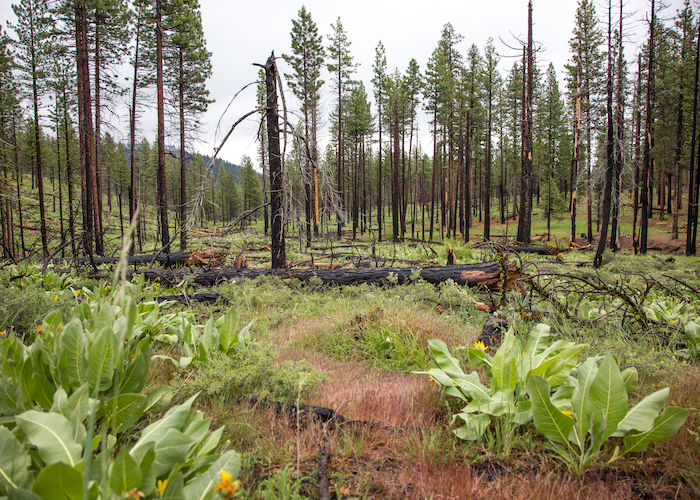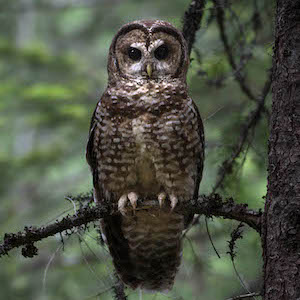When Andrew Stillman and field crews from The Institute for Bird Populations (IBP) tagged fledgling Black-backed Woodpeckers (Picoides arcticus) with radio transmitters in the summer of 2016, things did not go as expected. Black-backed Woodpeckers are post-fire specialists, and in the western United States are most frequently found in mixed- or high-severity burned forest. But when the researchers hiked into the center of large burns and turned on their receivers to begin tracking the fledglings, the signals quickly led them right out of the severely burned patches into unburned or less severely burned forest nearby. “We were floored,” Stillman said. “We thought that high-severity fire created good habitat for both fledglings and adults, but we consistently found fledglings in areas where plenty of live trees remained after fire.”

A radio-tagged Black-backed Woodpecker receives a grub from mom in low-severity burned forest. Photo by Morgan Tingley.
This study was part of Stillman’s dissertation, an exploration of Black-backed Woodpecker habitat use and population dynamics in response to variation in fire regime characteristics -- called “pyrodiversity” -- such as the age and severity of burned forest patches. The Black-backed Woodpecker is an iconic post-fire specialist, typically found in open, exposed stands of blackened snags that look bleak and barren if you're not a woodpecker. But these dead trees are quickly colonized by woodboring beetles -- many of which are attracted to the trees while the fires are still burning. The larvae of these beetles are large and protein-packed “like juicy hamburgers,'' quips Bob Wilkerson, a biologist with IBP and a coauthor of the study, and they are the woodpeckers' preferred prey.
In 2008, the US Forest Service designated the Black-backed Woodpecker a Management Indicator Species for burned forest in California’s Sierra Nevada. Little was known about the ecology of the birds at the time, so the Forest Service partnered with IBP to develop a monitoring strategy and begin amassing detailed information about the species. “The fire regime in California is changing rapidly and reshaping our forests,” says IBP executive director and ecologist Rodney Siegel, another coauthor of the study. “In recent years, climate change and a legacy of fire suppression have been yielding enormous ‘megafires’ in the region, with uncharacteristically large patches of forest burned at high severity.”
But the simple assumption that more fire always equals good news for a post-fire specialist wasn’t holding up. Stillman’s earlier work, in collaboration with IBP, his PhD advisor UCLA Professor Morgan Tingley, and the US Forest Service, showed that Black-backed Woodpeckers prefer to nest near the edge of severely burned patches. Now fledgling woodpeckers, hatched in nests within burned forests, were moving out of the burn and into adjacent forest that burned at low severity or sometimes hadn’t burned at all.
A new story began to emerge. Perhaps Black-backed Woodpeckers nest close to the edges of burned patches so that, upon fledging, their young can take cover in unburned or less severely burned patches nearby -- presumably to take advantage of greater vegetation cover and avoid predation. “We started thinking of the food-rich high severity burn as a grocery store and the high-cover low severity burn as a nursery,” says Stillman. “If you're going to build a home, you want to place it close to both the food source and the nursery!” But if this was indeed what was going on, you’d expect survival of juvenile woodpeckers to be higher in the less severely burned areas with more live vegetation.
To test this prediction, Stillman and collaborators tracked the habitat use and survival of 84 fledgling Black-backed Woodpeckers from 39 nests in seven different recently burned areas in the Sierra Nevada and Cascade Mountains of Washington and California. Tracking during the first 35 days was done the hard way -- hiking many rugged miles with handheld receivers. As the juveniles got older and dispersed, tracking was done by driving and with the generous help of the skilled volunteer pilots of LightHawk Conservation Flying.
“We expected survival to be lower in the high-severity patches compared to low-severity patches -- and that's what we show in this paper. However, it was surprising to us just how much of a difference it made,” says Stillman. “If you're a fledgling Black-backed Woodpecker, you have a 53% chance of surviving 35 days if you spend your time in low-severity burned patches -- about average for a baby bird. But if you instead choose to spend all your time in the high-severity burn (which is good habitat for adults), your chance of surviving 35 days plummets to just 13%.” Most fledgling deaths were due to predation.
Another surprise: the identity of the predators. Most juvenile Black-backed Woodpecker deaths could be attributed to birds of prey including Cooper's Hawks, Northern Goshawks, Red-tailed Hawks, and even a Western Screech-owl. Apparently if you are a bird of prey, fledgling woodpeckers in open stands of burned snags are the easy-to-grab, juicy hamburgers.
Previous research has shown that increased pyrodiversity yields more diverse habitat types across the landscape, which in turn increases diversity in the bird community. But this study and Stillman’s other dissertation research shows that pyrodiversity can be a good thing even for a single species. This is an example of habitat complementation: when a species has different habitat requirements for different parts of its life history. Forest managers can support and enhance pyrodiversity through management practices before fire, and by protecting pyrodiverse areas after fire.
Stillman sees a need for future research to assess whether other species associated with burns also benefit from pyrodiversity through habitat complementation. After all, “even the most fire-loving bird in North America needs variation in the intensity of the burn,” says Stillman. “Now we know why: fledglings seek cover, and if they don't, they're lunch!”
This blog post first appeared on the British Ecological Society's Animal Ecology in Focus blog. This paper is currently available on the journal's website or in the IBP publications database here.
Stillman, A.N., Lorenz, T.J., Fischer, P.C., Siegel, R.B., Wilkerson, R.L., Johnson, M. and Tingley, M.W. (2021), Juvenile survival of a burned forest specialist in response to variation in fire characteristics. J Anim Ecol. Accepted Author Manuscript. https://doi.org/10.1111/1365-2656.13456






